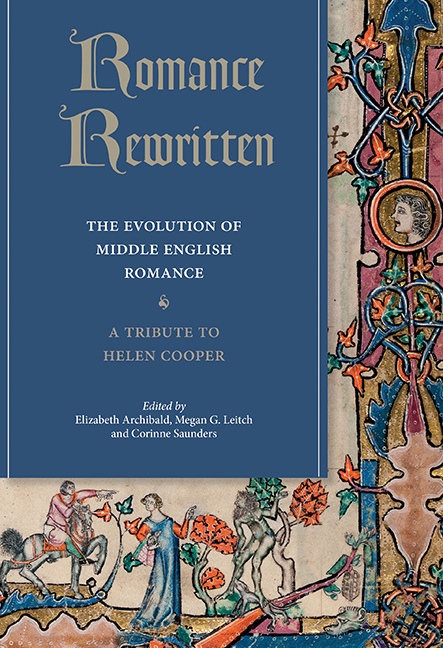Book contents
- Frontmatter
- Dedication
- Contents
- Notes on Contributors
- Acknowledgements
- Introduction. Middle English Romance: The Motifs and the Critics
- I Romance Disruptions
- II Romance and Narrative Strategies
- III Romance and Spiritual Priorities
- 8 Giving Freely in Sir Cleges: The Economy of Salvation and the Gift of Romance
- 9 From Magic to Miracle: Reframing Chevalere Assigne
- 10 Lifting the Veil: Voices, Visions, and Destiny in Malory's Morte Darthur
- IV Late Romance
- Works Cited
- Index
- Volumes Already Published
8 - Giving Freely in Sir Cleges: The Economy of Salvation and the Gift of Romance
from III - Romance and Spiritual Priorities
Published online by Cambridge University Press: 17 October 2019
- Frontmatter
- Dedication
- Contents
- Notes on Contributors
- Acknowledgements
- Introduction. Middle English Romance: The Motifs and the Critics
- I Romance Disruptions
- II Romance and Narrative Strategies
- III Romance and Spiritual Priorities
- 8 Giving Freely in Sir Cleges: The Economy of Salvation and the Gift of Romance
- 9 From Magic to Miracle: Reframing Chevalere Assigne
- 10 Lifting the Veil: Voices, Visions, and Destiny in Malory's Morte Darthur
- IV Late Romance
- Works Cited
- Index
- Volumes Already Published
Summary
Sir Cleges displays at least two major defining features of insular romance: it is a pious, moral tale, but is also marked by a concern with pragmatic matters, more specifically economic ones. Together with Sir Amadace and Sir Launfal, it belongs to a loosely defined group of romances that develop the motif of the ‘spendthrift knight’. The peculiar combination of piety and economics found in both Cleges and Amadace has proven rather baffling, and critics have frequently complained about the rather awkward yoking together of money and religion in these romances. Speaking of Amadace, for instance, Robert Foster points to the ‘ambiguous relation between idealism and materialism’, in a poem where ‘the situation is framed in such wholly economic terms that it is difficult to focus on the spiritual dimension that the poem's didactic intentions seem to call for’. It remains tempting to perform the usual secularising gesture, and argue that in such literature ‘there is a peculiar reduction of ideals to wealth’. In what follows I suggest that no such opposition or reduction of ‘ideals’ to ‘wealth’ is in fact discernible within such romances, where economics and salvation are articulated in far more complex, dynamic and meaningful ways that we have only begun to uncover.
An important step in this direction has already been taken by Ad Putter, with a brilliant reading of Sir Amadace, where he urges us to take the religious elements of such ‘bourgeois’ poems far more seriously, as integral components of the ideology they construct. Putter proposes something much more dynamic and more enabling than a didactic reading, and illustrates how in Amadace the notion of aristocratic largesse acquires a ‘religious remit’ and even a truly ‘metaphysical dimension’. This metaphysics of largesse develops around the central thematic and symbolic place of God in the narrative, presented as a dispenser of freely given divine grace and thus as the initiator of the economy of charitable gift-exchange celebrated in the poem. Often dismissed as a poem in which there is ‘little that is artful’, Sir Cleges constructs a similarly complex, subtle yet imaginatively powerful metaphysics of largesse. The poet pursues this objective in an unobtrusive, rhetorically economical yet remarkably self-conscious fashion. In what follows, then, I shall be arguing that the poem's symbolic, rhetorical, and material economies are interconnected in profound and complex ways, and produce a carefully and deliberately orchestrated ‘theological romance’.
- Type
- Chapter
- Information
- Romance RewrittenThe Evolution of Middle English Romance. A Tribute to Helen Cooper, pp. 155 - 172Publisher: Boydell & BrewerPrint publication year: 2018
- 1
- Cited by

